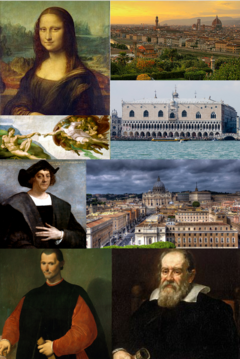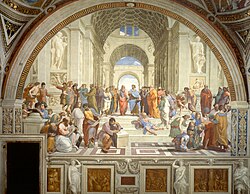 Global Information
Global InformationItalian Renaissance information
 Clockwise from top:
| |
| Date | 14th century – 17th century |
|---|---|
| Location | Italian city-states |
| Participants | Italian society |
| Outcome | Transition from the Middle Ages to the modern era
|
| Renaissance |
|---|
 |
| Aspects |
|
| Regions |
|
| History and study |
|
| History of Italy |
|---|
 |
|
Timeline |
The Italian Renaissance (Italian: Rinascimento [rinaʃʃiˈmento]) was a period in Italian history covering the 15th and 16th centuries. The period is known for the initial development of the broader Renaissance culture that spread across Western Europe and marked the transition from the Middle Ages to modernity. Proponents of a "long Renaissance" argue that it started around the year 1300 and lasted until about 1600.[1] In some fields, a Proto-Renaissance, beginning around 1250, is typically accepted. The French word renaissance (corresponding to rinascimento in Italian) means "rebirth", and defines the period as one of cultural revival and renewed interest in classical antiquity after the centuries during what Renaissance humanists labelled as the "Dark Ages". The Italian Renaissance historian Giorgio Vasari used the term rinascita ("rebirth") in his Lives of the Most Excellent Painters, Sculptors, and Architects in 1550, but the concept became widespread only in the 19th century, after the work of scholars such as Jules Michelet and Jacob Burckhardt.
The Renaissance began in Tuscany in Central Italy and centred in the city of Florence.[2] The Florentine Republic, one of the several city-states of the peninsula, rose to economic and political prominence by providing credit for European monarchs and by laying down the groundwork for developments in capitalism and in banking.[3] Renaissance culture later spread to Venice, the heart of a Mediterranean empire and in control of the trade routes with the east since its participation in the Crusades and following the journeys of Marco Polo between 1271 and 1295. Thus Italy renewed contact with the remains of ancient Greek culture, which provided humanist scholars with new texts. Finally the Renaissance had a significant effect on the Papal States and on Rome, largely rebuilt by humanist and Renaissance popes, such as Julius II (r. 1503–1513) and Leo X (r. 1513–1521), who frequently became involved in Italian politics, in arbitrating disputes between competing colonial powers and in opposing the Protestant Reformation, which started c. 1517.
The Italian Renaissance has a reputation for its achievements in painting, architecture, sculpture, literature, music, philosophy, science, technology, and exploration. Italy became the recognized European leader in all these areas by the late 15th century, during the era of the Peace of Lodi (1454–1494) agreed between Italian states. The Italian Renaissance peaked in the mid-16th century as domestic disputes and foreign invasions plunged the region into the turmoil of the Italian Wars (1494–1559). However, the ideas and ideals of the Italian Renaissance spread into the rest of Europe, setting off the Northern Renaissance from the late 15th century. Italian explorers from the maritime republics served under the auspices of European monarchs, ushering in the Age of Discovery. The most famous among them include Christopher Columbus (who sailed for Spain), Giovanni da Verrazzano (for France), Amerigo Vespucci (for Portugal), and John Cabot (for England). Italian scientists such as Falloppio, Tartaglia, Galileo and Torricelli played key roles in the Scientific Revolution, and foreigners such as Copernicus and Vesalius worked in Italian universities. Historiographers have proposed various events and dates of the 17th century, such as the conclusion of the European wars of religion in 1648, as marking the end of the Renaissance.[4]
Accounts of proto-Renaissance literature usually begin with the three great Italian writers of the 14th century: Dante Alighieri (Divine Comedy), Petrarch (Canzoniere), and Boccaccio (Decameron). Famous vernacular poets of the Renaissance include the epic authors Luigi Pulci (author of Morgante), Matteo Maria Boiardo (Orlando Innamorato), Ludovico Ariosto (Orlando Furioso), and Torquato Tasso (Jerusalem Delivered, 1581). 15th-century writers such as the poet Poliziano (1454–1494) and the Platonist philosopher Marsilio Ficino (1433–1499) made extensive translations from both Latin and Greek. In the early 16th century, Baldassare Castiglione laid out his vision of the ideal gentleman and lady in The Book of the Courtier (1528), while Niccolò Machiavelli (1469–1527) cast a jaundiced eye on la verità effettuale della cosa 'the effectual truth of things' in The Prince, composed, in humanistic style, chiefly of parallel ancient and modern examples of virtù. Historians of the period include Machiavelli himself, his friend and critic Francesco Guicciardini (1483–1540) and Giovanni Botero (The Reason of State, 1589). The Aldine Press, founded in 1494 by the printer Aldo Manuzio, active in Venice, developed Italic type and pocket editions that one could carry in one's pocket; it became the first to publish printed editions of books in Ancient Greek. Venice also became the birthplace of the commedia dell'arte.
Italian Renaissance art exercised a dominant influence on subsequent European painting and sculpture for centuries afterwards, with artists such as Leonardo da Vinci (1452–1519), Michelangelo (1475–1564), Raphael (1483–1520), Donatello (c. 1386–1466), Giotto (c. 1267–1337), Masaccio (1401–1428), Fra Angelico (c. 1395–1455), Piero della Francesca (c. 1415–1492), Domenico Ghirlandaio (1448–1494), Perugino (c. 1446–1523), Botticelli (c. 1445–1510), and Titian (c. 1488–1576). Italian Renaissance architecture had a similar Europe-wide impact, as practised by Brunelleschi (1377–1446), Leon Battista Alberti (1404–1472), Andrea Palladio (1508–1580), and Bramante (1444–1514). Their works include the Florence Cathedral (built from 1296 to 1436), St. Peter's Basilica (built 1506–1626) in Rome, and the Tempio Malatestiano (reconstructed from c. 1450) in Rimini, as well as several private residences. The musical era of the Italian Renaissance featured composers such as Giovanni Pierluigi da Palestrina (c. 1525–1594), the Roman School and later the Venetian School, and the birth of opera through figures like Claudio Monteverdi (1567–1643) in Florence. In philosophy, thinkers such as Galileo, Machiavelli, Giordano Bruno (1548–1600) and Pico della Mirandola (1463–1494) emphasized naturalism and humanism, thus rejecting dogma and scholasticism.
- ^ "Renaissance Historians of different kinds will often make some choice between a long Renaissance (say, 1300–1600), a short one (1453–1527), or somewhere in between (the fifteenth and sixteenth centuries, as is commonly adopted in music histories)." The Cambridge History of Seventeenth-Century Music (2005), p. 4, Cambridge University Press, Google Books. Or between Petrarch and Jonathan Swift (1667–1745), an even longer period. See Rosalie L. Colie quoted in Hageman, Elizabeth H., in Women and Literature in Britain, 1500–1700, p. 190, 1996, ed. Helen Wilcox, Cambridge University Press, ISBN 9780521467773, 0521467772, Google Books
- ^ Burke, P., The European Renaissance: Centre and Peripheries (1998)
- ^ Compre: Sée, Henri. "Modern Capitalism Its Origin and Evolution" (PDF). University of Rennes. Batoche Books. Archived from the original (PDF) on 2013-10-07. Retrieved 29 August 2013.
The origin and development of capitalism in Italy are illustrated by the economic life of the great city of Florence.
- ^ Florman, Samuel C. (2015). Engineering and the Liberal Arts: A Technologist's Guide to History, Literature, Philosophy, Art and Music. Macmillan. ISBN 9781466884991.
[...] Let us look for a moment at Europe just after the Treaty of Westphalia in 1648, almost two hundred years after the date that we choose to mark the transition from the Middle Ages to the Renaissance. [...] The religious war was over. The Reformation and the Counter-Reformation were things of the past. Truly we can say that the Renaissance had ended. [...]